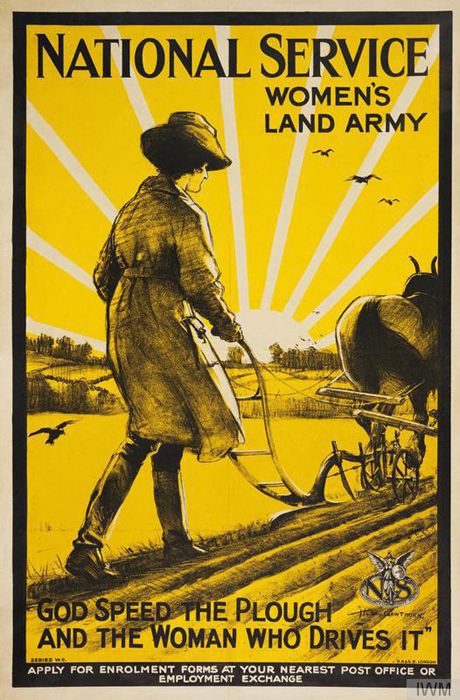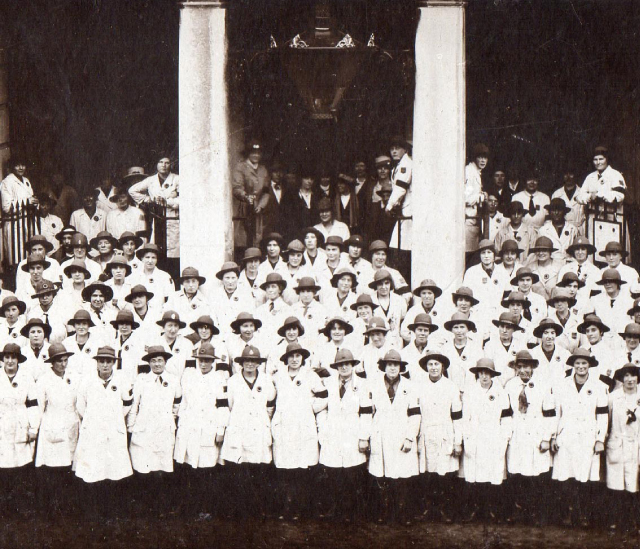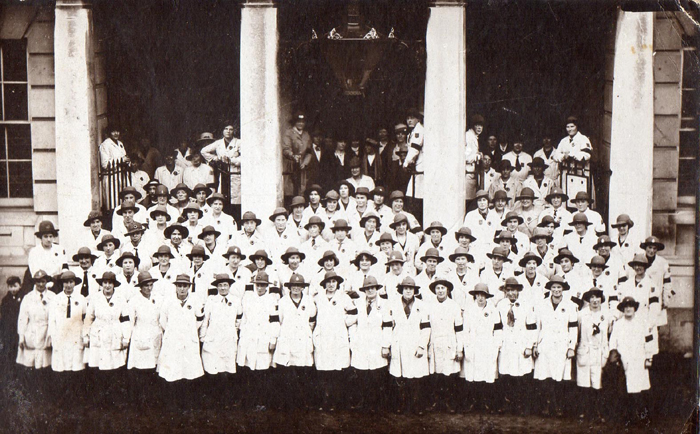During the First World War, Britain faced the risk of starvation. Huge numbers of men had joined the army and, as a result, farming and agriculture risked collapse. Meanwhile German U-Boats sank ships in the Atlantic in a bid to prevent food from reaching Britain. To keep Britain’s farmland productive, the Women’s Land Army stepped into the breach.

National Service – Women’s Land Army – God Speed the Plough and the Woman Who Drives It. © IWM (Art.IWM PST 5996)
Through a mix of recruitment and conscription, 5 million men joined the British army during the First World War. Industries that had been heavily staffed by men before the war, such as the postal service, found themselves suffering from shortages of workers. However, of greater concern was the possibility of Britain being starved into submission.
Food Shortages
As an imperial power, Britain relied upon trade and imports from its empire. The country only produced 35% of its required food in the years before the First World War. The Royal Navy had always acted as a guarantor for British shipping around the world. The emergence of German U-Boats during the First World War threatened this policy. Striking without warning from beneath the waves and, at various points in the war, operating a policy of unrestricted action against all shipping, German submarines represented a threat which the Royal Navy was struggling to deal with. The eventual decision to institute convoys for all shipping across the Atlantic would reduce the danger from U-Boat attack, but they did not become a regular feature until 1917.
Rationing was introduced to Britain in 1918 to deal with food shortages, but even before then, a dedicated poster campaign had sought to educate the public of the results of wasting food and the dangers experienced by men in the merchant navy who were risking their lives to bring food into the country.
- Eat Less Bread Web. Courtesy of Eastbourne Libraries
- Eat Less Bread. Courtesy of Eastbourne Libraries
To ensure that supplies lasted and ingredients were stretched as far as possible, new recipes and cooking techniques became popular as the war continued.
However, in order to feed both the population at home and the army abroad, the farming and agriculture industries began to employ women to meet the shortfall in workers as men headed into the army.
Women’s Land Army
An already difficult situation became dramatically more dangerous in 1917 when the British harvest failed. Faced with enough food for only a few more weeks, disaster, and eventually defeat, loomed large on the horizon. In a bid to rescue the situation, the Board of Agriculture convened to create the Women’s Land Army (WLA); a dedicated group for women to take over important jobs and tasks within the farming and agricultural worlds.
Women had actually been working the fields in Sussex since 1916. Lady Cowdray and the Countess of Chichester had worked to form Women’s Agricultural Committees in the county. These were designed to combat the deeply rooted prejudices within the farming industry at the time in regard to women workers. The Committees sought to provide training places, free of charge, to women for milking, hop-picking and fruit growing. In addition to this, Lady Frances Wolseley, renowned for her love of horticulture, declared that she had 2,800 women ready to undertake farm work to aid the nation.
- Women’s Land Army in Britain © IWM (Q 30680)
- Women’s Land Army in Britain © IWM (Q-30657)
- Women’s Land Army in Britain © IWM (Q 30677)
The Women’s Land Army participated in most forms of farming for the remainder of the war. Women milked cows, ploughed fields and harvested crops. In exchange for their services, they were generally paid 25 shillings a week minus 17 shillings for board.
Additionally, the Women’s Forestry Corps worked alongside the WLA in East Sussex. The Forestry Corps combined elements of military formation, uniform and discipline with the same objectives of the WLA. In 1917 and 1918, khaki-clad women felled trees in Heathfield and were also sent to the East Sussex/Kent border to work in the forests of Tunbridge Wells.
The End of the War
The Women’s Land Army was formally disbanded in 1919. Their efforts had ensured that the country had stayed on its feet during the last years of the war. However, the returning numbers of men from the battlefields of Europe and beyond meant that most women who had stepped into employment in organisations such as the WLA were either released from their contracts or fired to make way for the men.
There was recognition for their efforts though. In 1919, members of the Women’s Land Army from East Sussex were participants in a medal presentation and ‘stand down’ march through the town of Lewes. The group ‘Women’s Land Army Tribute‘ are planning to create a permanent monument to the women of the Land Army from both World Wars at the National Arboretum.
Sources
Sussex in the First World War by Keith Grieves














